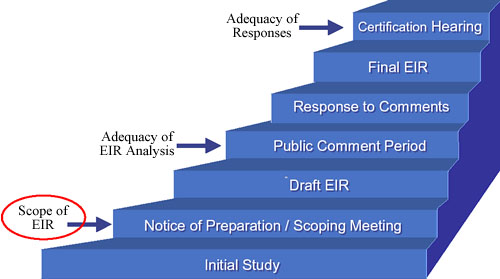
An Environmental Impact Report (EIR) responds to the California Environmental Quality Act (CEQA), legislation intended to asses and address the environmental impacts of large developments, such as air-quality, construction debris and dust, noise and other factors. It takes only a few minutes reviewing the EIR of a large commercial development to realize that its use of quasi-scientific methods produces a dehumanized document all but inaccessible to the general public.
Large development requires major financial commitment, and all real estate investment is predicated upon projected forecasts of profits and return-on-investment. Such forecasts attempt to use reasonable assumptions about income and expenses; the larger the project and length of forecast, the greater the risk such assumptions are inaccurate. An accurate assessment of risk is vital to successfully predicting outcomes, but forecasting the future is always speculative.
The purpose of CEQA and an EIR it requires is essentially the same: determining the likely outcomes and environmental effects of a large project while attempting to reduce the risk of harm to the environment – the health of people, contamination of land and water, and effects on transportation.
Forecasting the future requires establishing baseline measurements of current conditions and attempting to determine how proposed projects will affect those measurements. In other words, an attempt to employ a “scientific” method to assess probabilities is what the EIR process entails. Accordingly, an EIR is a data-driven document, since only by reducing environmental factors to quantifiable, calculable numbers is it possible to predict probabilities. The difficulty, however, is that human beings and non-quantifiable factors such as quality-of-life, sense-of-place and community character cannot be reduced to calculable units. This is why an EIR becomes a dehumanized process.
The preparation of an EIR is the work of specialists. These specialists have expertise in the environmental regulations that must be satisfied and ways to satisfy them. Their method, after identifying potential impacts, is to decide if the project impacts are significant or less-than-significant. If they are deemed significant (as determined by calculations and forecasts) then they must be mitigated, and the EIR includes such mitigations. The work of EIR specialists is essentially opaque to anyone not a specialist, and challenging an EIR requires comparable specialist expertise. The appendix alone of a current project before the Planning Commission is 413 pages long. When reduced to pages of “objective” data, the “subjective” human element is unfortunately left far behind.
Thus the evaluation of auto traffic, for example, becomes a matter of objective measurement – traffic counts and trip generation pertaining to “test periods” or comparisons with comparable projects. Yet, traffic studies are not the same as the experience of living in a community day-to-day and gaining a “feel” for how things are or how they change over time. “Feelings” are not scientifically quantifiable or calculable, even though they are at the heart of human experience. Thus they find no place in CEQA or an EIR.
CEQA and an EIR have value, but are simply one element in determining if a proposed large project is right for a community. Applying a “scientific” methodology to human culture is tempting and seductive, but far from definitive. Therefore, it’s worth remembering that both CEQA and an EIR are specifically intended to protect the environment for living things – like people – and their safety, health and welfare.